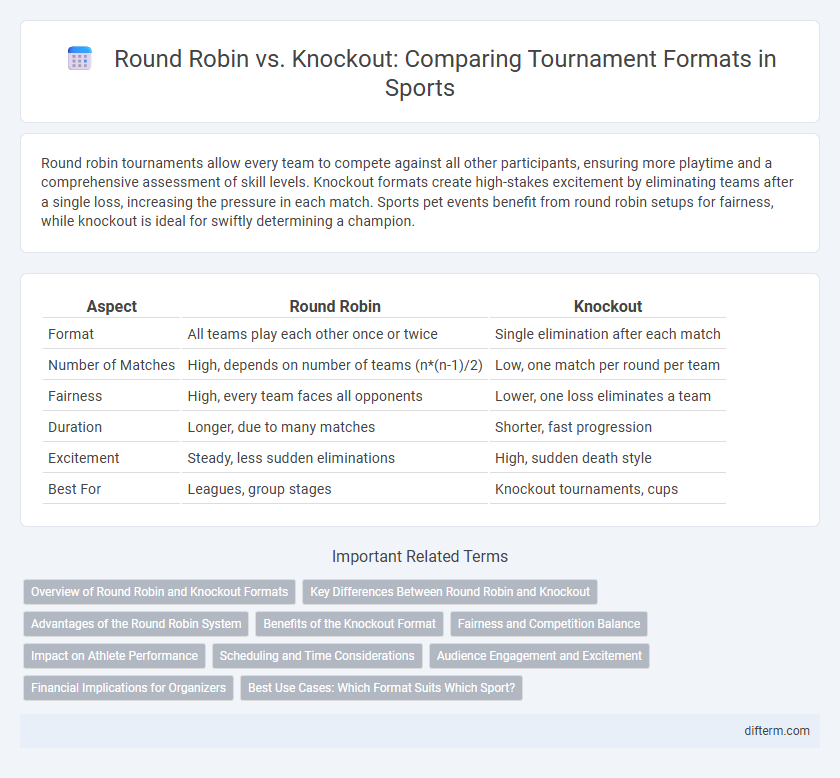Round robin tournaments allow every team to compete against all other participants, ensuring more playtime and a comprehensive assessment of skill levels. Knockout formats create high-stakes excitement by eliminating teams after a single loss, increasing the pressure in each match. Sports pet events benefit from round robin setups for fairness, while knockout is ideal for swiftly determining a champion.
Table of Comparison
| Aspect | Round Robin | Knockout |
|---|---|---|
| Format | All teams play each other once or twice | Single elimination after each match |
| Number of Matches | High, depends on number of teams (n*(n-1)/2) | Low, one match per round per team |
| Fairness | High, every team faces all opponents | Lower, one loss eliminates a team |
| Duration | Longer, due to many matches | Shorter, fast progression |
| Excitement | Steady, less sudden eliminations | High, sudden death style |
| Best For | Leagues, group stages | Knockout tournaments, cups |
Overview of Round Robin and Knockout Formats
Round robin format ensures every team competes against all other teams, promoting fairness and comprehensive performance evaluation. Knockout format eliminates teams after each losing match, intensifying competition and reducing tournament length. Both formats impact strategy, viewer engagement, and scheduling in sports events.
Key Differences Between Round Robin and Knockout
Round robin tournaments feature all teams or players competing against each other, ensuring multiple games and a comprehensive assessment of skill, while knockout formats involve single-elimination matches where losing results in immediate exit from the competition. Round robin allows for consistency to be rewarded and reduces the chance factor in progression, whereas knockout formats heighten excitement and stakes through sudden-death scenarios. The choice between round robin and knockout impacts scheduling, fairness, and viewer engagement in sports events.
Advantages of the Round Robin System
The round robin system guarantees that every team competes against all other participants, ensuring a fair and comprehensive assessment of skill levels. This format maximizes playing time and opportunities for teams to improve by gaining experience through multiple matches. It reduces the impact of a single loss, providing a more accurate reflection of overall performance compared to the knockout system.
Benefits of the Knockout Format
The knockout format ensures high-stakes competition by eliminating teams immediately after a loss, intensifying match excitement and viewer engagement. This structure shortens tournament duration, allowing organizers to schedule events efficiently and reduce operational costs. It also promotes peak performance, as teams must deliver their best in every match to advance, heightening competitive intensity.
Fairness and Competition Balance
Round robin tournaments ensure fairness by allowing every team to compete against all others, minimizing luck and performance anomalies. Knockout formats introduce high stakes with single-elimination rounds, which can create unpredictable outcomes but may unfairly eliminate strong contenders early. The round robin system promotes consistent competition balance, while knockout prioritizes excitement and finality at the risk of reduced fairness.
Impact on Athlete Performance
Round robin tournaments enhance athlete performance by providing multiple competitive opportunities that foster skill development and consistency under pressure, reducing the impact of a single loss. Knockout formats create high-stakes environments that test an athlete's mental toughness and peak performance in every match but may lead to elevated stress levels and inconsistent performance outcomes. The choice between the two formats directly influences an athlete's ability to maintain optimal physical and psychological states throughout a competition.
Scheduling and Time Considerations
Round robin tournaments require more scheduling flexibility as each team plays against all opponents, resulting in a higher total number of matches and extended event duration. Knockout formats prioritize shorter timelines by eliminating teams after each round, reducing the total number of games and allowing for quicker tournament completion. Efficient time management in round robin involves balancing rest periods and match frequency, while knockout demands precise scheduling to accommodate sudden eliminations and potential tiebreakers.
Audience Engagement and Excitement
Round robin tournaments offer sustained audience engagement as fans follow every team through multiple games, increasing investment in overall outcomes. Knockout formats heighten excitement with do-or-die matches, creating intense, high-stakes moments that captivate viewers instantly. The balance of continuous interest versus peak thrill defines audience preferences in sports event structures.
Financial Implications for Organizers
Round robin tournaments often require higher operational costs due to the increased number of matches, leading to greater expenses in venue rental, staffing, and logistics. Knockout formats can reduce these costs significantly by limiting the number of games, but they may also result in lower cumulative ticket sales and broadcasting revenue. Organizers must balance the predictability of financial returns with the scale of engagement when choosing between round robin and knockout structures.
Best Use Cases: Which Format Suits Which Sport?
Round robin format suits sports like soccer, cricket, and basketball where each team benefits from playing multiple matches to demonstrate consistency and skill over time, ensuring fair competition and reducing the impact of a single loss. Knockout format is ideal for tennis, boxing, and golf tournaments where a direct elimination creates high-stakes excitement and faster progression towards a champion. Choosing the appropriate format depends on factors like the number of participants, scheduling constraints, and the desired balance between fairness and entertainment value.
round robin vs knockout Infographic

 difterm.com
difterm.com